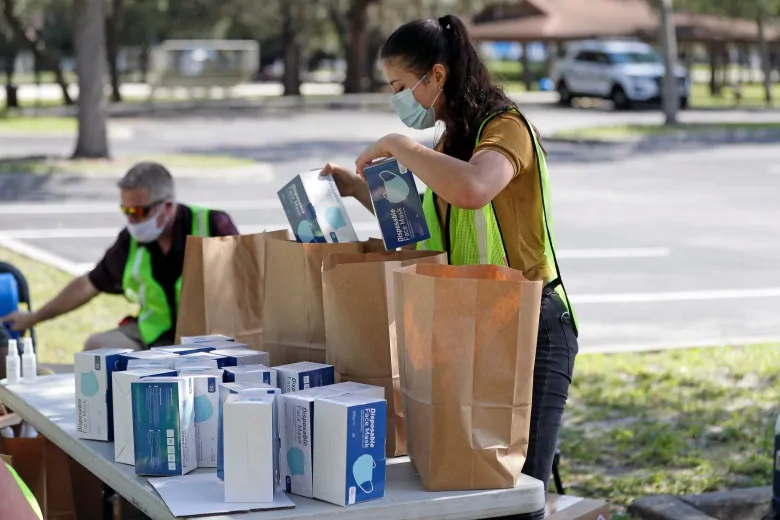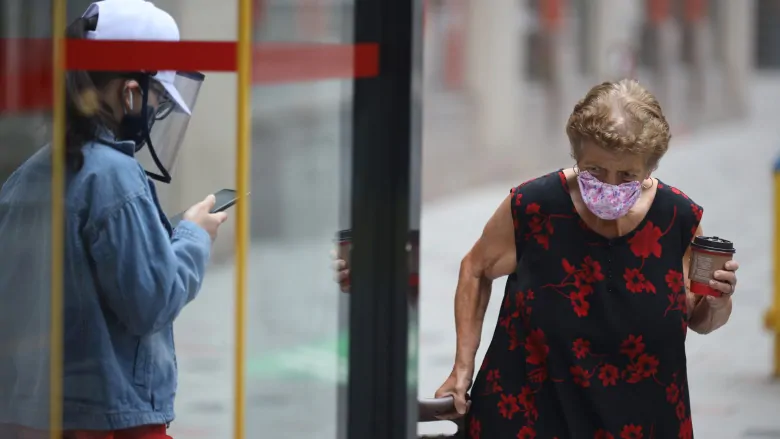The latest:
A coronavirus resurgence is wiping out two months of progress in the U.S. and sending infections to dire new levels across the country’s South and West, with hospital administrators and health experts warning Wednesday that politicians and a tired-of-being-cooped-up public are letting a disaster unfold.
The U.S. recorded a one-day total of 34,700 new COVID-19 cases, just short of the nation’s late-April peak of 36,400, according to the count kept by Johns Hopkins University.
While new cases have been declining steadily in early U.S. hotspots such as New York and New Jersey, several other states set single-day case records this week, including Arizona, California, Mississippi, Nevada, Texas and Oklahoma. Some of them also broke hospitalization records, as did North Carolina and South Carolina.
“People got complacent,” said Dr. Marc Boom, CEO of the Houston Methodist hospital system. “And it’s coming back and biting us, quite frankly.”
WATCH | Long lines at COVID-19 test sites in U.S.:
The stock market slid sharply Wednesday as the virus’s resurgence clouded investors’ hopes for a relatively quick economic turnaround. The virus has been blamed for more than 120,000 deaths in the U.S. — the highest toll in the world — and more than 2.3 million confirmed infections there.
California, the most populous state, reported over 7,100 new cases, a record. Florida’s single-day count of new confirmed cases surged Wednesday to 5,500 — a 25 per cent jump from the record set last week.
In Texas, which began lifting its shutdowns on May 1, hospitalizations have doubled and new cases have tripled in two weeks. Gov. Greg Abbott told KFDA-TV that the state is facing a “massive outbreak” and might need new local restrictions to preserve hospital space.
The Houston area’s intensive care units are nearly full, and two public hospitals are running at capacity, Mayor Sylvester Turner said. Houston Methodist’s Boom said Texans need to “behave perfectly and work together perfectly” to slow the infection rate.
“When I look at a restaurant or a business where people … are not following the guidelines, where people are just throwing caution to the wind, it makes me angry.”

Just 17 percent of intensive-care beds were available Wednesday in Alabama — including just one in Montgomery — though hospitals can add more, said Dr. Don Williamson, head of the Alabama Hospital Association.
“There is nothing that I’m seeing that makes me think we are getting ahead of this,” he said.
In Arizona, emergency rooms are seeing about 1,200 suspected COVID-19 patients a day, compared with around 500 a month ago. If the trends continue, hospitals will probably exceed capacity within the next several weeks, said Dr. Joseph Gerald, a University of Arizona public health policy professor.

“We are in deep trouble,” said Gerald, urging the state to impose new restrictions on businesses, which Gov. Doug Ducey has refused to do.
Infectious-disease expert Dr. Peter Hotez said he worries that the states will squander what time they have to head off a much larger crisis.
“We’re still talking about subtlety, still arguing whether or not we should wear masks, and still not understanding that a vaccine is not going to rescue us,” said Hotez, of the Baylor College of Medicine in Texas.
Texas Gov. Greg Abbott initially barred local officials from fining or penalizing anyone for not wearing a mask as the state reopened. After cases began spiking, he said last week that cities and counties could allow businesses to require masks. Both Abbott and Ducey are Republicans.

North Carolina Gov. Roy Cooper, a Democrat, ordered people to wear masks in public as the daily count of hospitalizations and new cases hovered near records. In Florida, several counties and cities have recently started requiring masks in public places and cracking down on businesses that don’t enforce social distancing rules.
In a sign of the shift in the outbreak, New York, Connecticut and New Jersey announced they will require visitors from states with high coronavirus infection rates to quarantine themselves for 14 days. That is a turnaround from March, when Florida Gov. Ron DeSantis issued such an order for visitors from the New York City area, where cases were surging at the time.
Cases are also surging in some other parts of the world. India reported a record daily increase of nearly 16,000 new cases, with an outbreak in the capital city of New Delhi becoming a rising concern. Mexico, where testing rates have been low, also set a record with more than 6,200 new cases.

But China appears to have tamed a new outbreak in Beijing, once again demonstrating its ability to quickly mobilize its vast resources by testing nearly 2.5 million people in 11 days. China on Wednesday reported 12 cases nationwide, down from 22 the day before.
In Europe, countries are both easing and increasing restrictions as the outbreaks evolve. Slovenia reintroduced mandatory use of face masks in public transportation and other enclosed public spaces after cases spiked in recent days, while Belgium said theatres and swimming pools could reopen next month. Infections there have nosedived over the past two months.
WATCH | Belgian entrepreneur gives coronavirus masks the human touch:
In Africa, the head of the Ethiopia-based Africa Centers for Disease Control and Prevention, John Nkengasong, said the outbreak is “picking up speed very quickly,” with a steep increase in cases and deaths as more countries loosen lockdowns. Africa has seen nearly 325,000 cases and over 8,600 deaths.
Worldwide, more than 9.3 million people have been confirmed infected, and more than 479,000 have died, according to the Johns Hopkins count.
What’s happening with COVID-19 in Canada
As of 7 p.m. ET on Wednesday, Canada had 102,241 confirmed and presumptive coronavirus cases. Provinces and territories listed 65,091 of the cases as recovered or resolved. A CBC News tally of deaths based on provincial reports, regional health information and CBC’s reporting stood at 8,530.
In Ontario, patios and hair salons were back in business in Toronto and Peel Region on Wednesday.
Premier Doug Ford also announced a plan to reopen parts of Windsor-Essex, which until now has been the only region not cleared to move to the next phase of reopening, due to stubbornly high COVID-19 case numbers among migrant workers on farms in the region.

British Columbia is further easing restrictions, meaning residents will be allowed to travel within the province as hotels, motels, resorts, spas and RV parks look to reopen.
Premier John Horgan announced Wednesday that B.C. will gradually be moving into Phase 3 of its restart plan, after the province managed to increase activity without seeing a spike in the number of COVID-19 cases in recent weeks.
Phase 3 of B.C.’s restart plan also means residents can travel within the province “safely and respectfully.”

Canada’s Atlantic provinces announced Wednesday they will move forward with a so-called travel bubble as of July 3, allowing travellers in Prince Edward Island, New Brunswick, Nova Scotia and Newfoundland and Labrador to move between provinces without self-isolating.
Visitors from provinces and territories outside the region will still be required to self-isolate for 14 days and adhere to the local entry requirements in each of the four jurisdictions. However, once the self-isolation period has passed, these visitors will also be allowed to travel within the Atlantic region.





More Stories
Allegations of corruption Qatar warns of ‘negative impact’ of European measures
USA: Famous “Hollywood cat” euthanized in Los Angeles
The campaigner who called for the shooting of Ukrainian children has not been charged